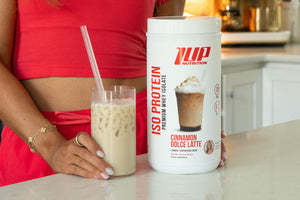You’ve likely heard (probably from your parents) that “breakfast is the most important meal of the day.”
And, while that old adage may hold true for some individuals, it doesn’t necessarily apply to everyones, especially in the context of weight loss.
You see, when it comes to losing weight, calories reign supreme.
Regardless of when you eat your calories, be it morning, noon, or night (or somewhere in between), as long as you’re eating less than your body needs to maintain its weight at the end of the day, you will lose fat.
This is why studies show that both breakfast eaters and breakfast skippers (like intermittent fasters) can both lose weight[1,2,3] -- for weight loss it all boils down to calories in vs calories out.
If you’re an individual who loves to eat breakfast, we’ve got 5 tips to help you maximize your morning meal’s impact on weight loss.
5 Breakfast Rules for Weight Loss
#1 Pile on the Protein
Protein should be the cornerstone of every meal.
It supplies the body with the essential amino acids it needs to build and repair muscle tissue. Protein is also needed to build neurotransmitters, synthesize hormones, and support immune function.
In regards to weight loss, protein is the most satiating macronutrient, which helps keep you feeling fuller for longer.
Protein also has a higher thermic effect of feeding (TEF) compared to carbohydrates or fats, which means your body has to expand more energy to digest protein-rich foods than it does ones rich in carbs or fats. This also supports weight loss.
Consuming a high protein diet also helps protect against unwanted muscle breakdown during dieting, which helps keep your metabolic rate higher, thereby allowing you to diet on a higher amount of calories while still losing weight.
Research also shows that high-protein breakfasts help set you up for success the rest of the day by reducing food intake the rest of the day and regulating appetite hormones.[4]
Some of our favorite high-protein breakfasts include:
- Scrambled eggs
- Veggie omelet
- Greek yogurt & mixed berries
- Protein oatmeal
- Protein smoothie
#2 Choose Savory over Sweet
Traditional breakfast fare for the non-fitness enthusiast usually includes the likes of toaster pastries, doughnuts, pancakes, or some kind of high-carb, sugar-laden breakfast cereal.
While these foods might be tasty, they are woefully low in both protein and fiber, while being high in sugar, fat, and calories.
These high-sugar meals can spike insulin levels which sets blood sugar levels on a roller coaster adventure than initially has individuals feeling energized, but in just a short while, they crash and feel incredibly fatigued.
Savory breakfast fare (eggs, bacon, etc.) tends to be higher in protein and lower in sugar, which can help keep you feeling full while also providing more stable energy levels.
#3 Avoid Drinking Your Breakfast
“Breakfast” for many on-the-go professionals these days is a king-sized coffee from their favorite gourmet coffee bar.
These beverages are indeed delicious and energizing (thanks to the combination of lots of caffeine and sugar). But, they’re also bloated with empty calories and void of any substantial amounts of protein.
These liquid calories do little to make you feel full, but they do take a considerable chunk out of your daily calorie allowance, which makes it that much more likely you’ll end up overeating by the end of the day.
Coffee is a fine way to start the day, but if at all possible, avoid loading it full of sugar, creamers, butter, or MCT oil. None of these additions have any mystical fat-burning properties, despite what the “gurus” tell you.
The same goes for fruit juices and smoothies made just from fruit. They’re high in calories and do little to actually fill you up.
If you are on the go and want to have a portable breakfast you can drink while you commute, consider making a protein smoothie, using 1UP whey protein, fresh/frozen fruit, frozen spinach, nut butter, ice, and milk of choice.
This can be whipped up in a minute, tailored to any flavor/dietary preferences, and costs a fraction of what you’ll pay for some froo-froo drive-thru coffee or juice.
#4 Use a Plate
Building off the last point, many of us choose to eat breakfast on-the-go in the name of getting things done and #grinding 24/7.
But, if you can, try to take a moment to pause and sit down to enjoy a meal.
Food is meant to be savored, relished, and enjoyed. It’s not meant to be shoveled in while you’re hustling and bustling.
Taking the time to be present while you eat your food can help you have a better gauge on portion control as well as help you eat slower (which gives your brain more time to realize if you’ve had enough to eat or not).
Mindfulness is one of the most important (and easiest) things you can do to help keep calorie intake in check and boost weight loss.
#5 Pump Up the Volume
Higher volume foods can help with satiety and calorie intake in the short term compared to lower volume foods of similar energy density.[5]
For those of you unsure what “high volume” foods are, they are foods that take up a lot of space on the plate (and in your stomach), but have relatively low energy density.
These are foods like fruits and vegetables -- foods that are very filling, but have few calories compared to other foods of similar size.
Processed and packaged foods are categorized as high energy density, low volume foods since they pack a lot of calories for the actual amount of food you’re consuming.
Increasing your intake of low-energy-dense foods during breakfast (and other meals) can promote satiety and help control hunger.[6]
Basically, if you’re looking for a way to make yourself feel fuller at breakfast, even if you’re on a reduced-calorie diet, opt for high volume, low energy foods like fruits and veggies -- berries, greens, non-starchy vegetables, etc.
Takeaway
Whether you eat breakfast everyday or only every now and then, these tips can help you get the most from your breakfast.
Focus on high-protein, high-volume foods while limiting liquid calories, and you’ll be well on your way to making breakfast a mainstay in weight loss diet plans!
References
- Sievert, K., Hussain, S. M., Page, M. J., Wang, Y., Hughes, H. J., Malek, M., & Cicuttini, F. M. (2019). Effect of breakfast on weight and energy intake: systematic review and meta-analysis of randomised controlled trials. BMJ, 364. https://doi.org/10.1136/bmj.l42
- Brikou D, Zannidi D, Karfopoulou E, Anastasiou CA, Yannakoulia M. Breakfast consumption and weight-loss maintenance: results from the MedWeight study. Br J Nutr. 2016;115(12):2246-2251. doi:10.1017/S0007114516001550
- Juliane Richter, Nina Herzog, Simon Janka, Thalke Baumann, Alina Kistenmacher, Kerstin M Oltmanns, Twice as High Diet-Induced Thermogenesis After Breakfast vs Dinner On High-Calorie as Well as Low-Calorie Meals, The Journal of Clinical Endocrinology & Metabolism, Volume 105, Issue 3, March 2020, Pages e211–e221, https://doi.org/10.1210/clinem/dgz311
- Wang S, Yang L, Lu J, Mu Y. High-protein breakfast promotes weight loss by suppressing subsequent food intake and regulating appetite hormones in obese Chinese adolescents. Horm Res Paediatr. 2015;83(1):19-25. doi:10.1159/000362168
- Żurakowski A, Zahorska-Markiewicz B, Olszanecka-Glinianowicz M, Kocelak P. Effect of Meal Volume on Hunger and Satiety in Obese Subjects: Volume of meal and satiety. EJIFCC. 2006;17(4):167-176. Published 2006 Dec 1.
- Rolls BJ. Dietary energy density: Applying behavioural science to weight management. Nutr Bull. 2017;42(3):246-253. doi:10.1111/nbu.12280






